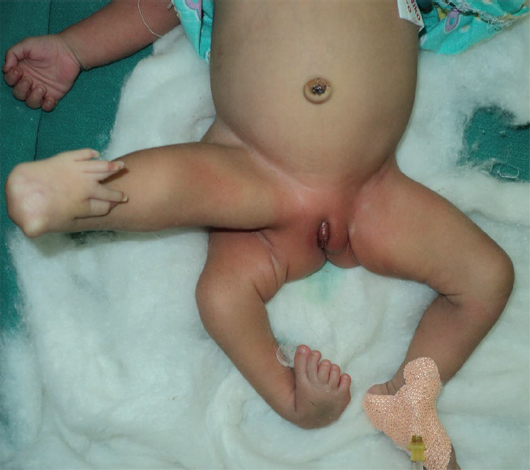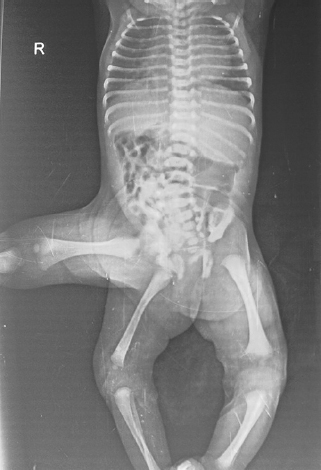Translate this page into:
Extra lower limb - A rare parasitic twin variety
*For correspondence: drashishchhabra@yahoo.co.in
-
Received: ,
This is an open access journal, and articles are distributed under the terms of the Creative Commons Attribution-NonCommercial-ShareAlike 4.0 License, which allows others to remix, tweak, and build upon the work non-commercially, as long as appropriate credit is given and the new creations are licensed under the identical terms.
This article was originally published by Wolters Kluwer - Medknow and was migrated to Scientific Scholar after the change of Publisher.
A 20 day old female child† presented to the Pediatric Surgery outpatient department in Guru Gobind Singh Medical College and Hospital, Faridkot, India, in March 2015, with an extra right lower limb. A parasitic limb having a malformed foot was originating from the anterolateral aspect of the right inguinal region (Fig. 1). The right lower limb bearing club foot was shorter and had restricted mobility due to the overlying parasitic limb. Pelvic X-ray and magnetic resonance imaging showed normal hip joint, femur and thigh muscles of parasitic limb, however muscles and bones of the leg region were hypoplastic (Figs 2 and 3). The child underwent surgery in the form of 'Parasitic Limb Disarticulation' so as to prevent the right lower limb from 'Steal syndrome'. Exploration revealed a well-formed hip joint, neurovascular bundle and musculature (Figs 4 and 5). The baby recovered well, and on six months follow up showed improvement in the function and growth of the preserved right lower limb.

- A parasitic lower limb arising from the anterolateral aspect of the right inguinal region.

- X-ray of the pelvis (anteroposterior view).

- Magnetic resonance imaging pelvis showing the parasitic limb with the hip joint and femur.

- Neurovascular bundle of the parasitic limb.

- Acetabulum of the parasitic limb hip joint.
Neonates with this rare parasitic twin anomaly should be offered early surgical intervention to prevent the 'Steal syndrome' and the resultant decrease in the growth and functionality of the ipsilateral normal limb.
Conflicts of Interest: None.





